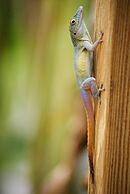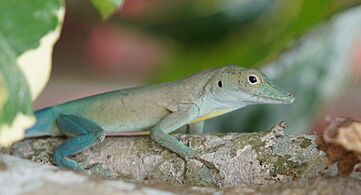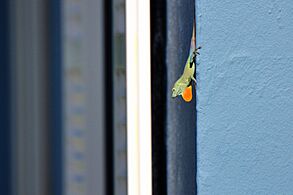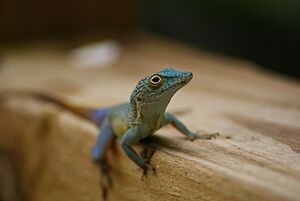Jamaican turquoise anole facts for kids
Quick facts for kids Jamaican turquoise anole |
|
|---|---|
 |
|
| Conservation status | |
| Scientific classification | |
| Genus: |
Anolis
|
| Species: |
grahami
|
| Synonyms | |
The Anolis grahami, also known as the Jamaican turquoise anole or Graham's anole, is a type of lizard. It belongs to the family Dactyloidae. This lizard naturally lives on the island of Jamaica. It has also been brought to Bermuda. The Jamaican turquoise anole is one of many anole species found in Jamaica. There are two known subspecies of this lizard.
Contents
What's in a Name?
The name grahami was given to this lizard to honor James Duncan Graham. He started the Corps of Topographical Engineers in the United States Army.
About the Jamaican Turquoise Anole
The Jamaican turquoise anole is a very colorful lizard. Its upper body is often a bright emerald or aquamarine blue-green. Its main body and legs are a deep blue. It has a bright orange dewlap, which is a flap of skin under its chin. The first part of its tail is deep blue, and the lower part is a shiny violet. Its belly is usually a light blue-gray.
Sometimes, especially in females and younger lizards, these colors might be a bit softer. But they are still very bright. Fully grown males can be incredibly colorful. You might even see a lizard that is pure turquoise blue.
Adult male Anolis grahami can grow up to 16 centimeters (about 6.3 inches) long. This includes their tail. Their body length, from snout to vent, is about 8 cm (3.1 inches). Females are usually smaller than males. When males fight over their space or feel threatened, they can raise a small crest on top of their heads.
How They Change Color
These lizards can change their color. They do this to blend in with their surroundings when needed. Under their skin are special cells called chromatophores. These cells give the lizard its normal colors. Below these are other cells called melanocytes. These cells contain a dark pigment called melanin.
When the lizard's body hormones change, these melanocyte cells can spread out. This covers up the regular color cells. This makes the lizard change to a darker color. So, the anole can change from bright blue to different shades of brown or even almost black when it is stressed. Often, the end of the tail or part of the body stays colored during this change. These lizards can even change the color of only one half of their bodies!
Lizard Family Tree
Two types of Anolis grahami are officially recognized. These are like different versions of the same species.
- Anolis grahami aquarum Underwood & E. Williams, 1959 – Found in Portland Parish and St. Thomas Parish, Jamaica
- Anolis grahami grahami Gray, 1845 - Found in most parts of northern, western, southern, and central Jamaica
The Anolis grahami belongs to a large group called Squamata. This group includes all scaled reptiles. It is the most common group of reptiles. It has snakes, lizards, and worm lizards. You can find Squamata species all over the world, except in Antarctica. Because they live in so many different places, other lizards in this group have very different features.
Body Structure
Anolis grahami lizards have a special movable joint in their skull. This is called the quadratojugal hinge. It is a key feature of the Squamata group. Lizards in this group have a jaw structure that gives them more flexibility when biting. They also have strong jaw muscles. This helps them bite with more power.
The Squamata group is divided into smaller groups. The Anolis grahami is part of the Iguania group. Iguania is a group of reptiles that includes many species. These are iguanas, chameleons, and New World lizards like the Anolis grahami. Most species in this group live in trees, just like the Anolis grahami. But some rare ones live on the ground. Members of this group usually have soft tongues that cannot grab things.
Where They Fit In
Anolis grahami is part of the Dactyloidae family. This family is a smaller group within Iguania. Dactyloidae lizards are found from the southeastern United States down to Paraguay. They are commonly called anoles. Lizards in this group often have green or brown bodies. Like the Anolis grahami, many can change colors. Other common traits of Dactyloidae, seen in the Anolis grahami, include being able to break off their tail if trapped. They also have a brightly colored dewlap under their necks. This dewlap is used for showing off.
If you compare different species of Anolis, you will see they have many different features. This is true even though they are in the same group. This is mainly because they live in many different places and conditions. They have developed in different ways to best suit their environment. For example, Anolis grahami tend to have longer legs than lizards that live on the ground. This is because they need long legs to climb and walk on tree branches. Even among tree-dwelling anoles, leg length can vary. Longer legs are needed for wider branches.
Where They Live
Jamaica
The Anolis grahami is found all over the island of Jamaica. You can see them in all fourteen of Jamaica's areas, called parishes. There are fewer A. grahami in the southern parts of St. Catherine, Clarendon, and Manchester. But you can still find some there. In Jamaica, only the Anolis lineatopus lizard is more common. The Graham's anole can be found in both mountains and lowlands.
Bermuda
In Bermuda, the Anolis grahami is not native. It was brought there by people. It was the first of three anole species introduced to the island. Before it arrived, the Bermuda rock skink (Plestiodon longirostris) was the only lizard there. Now, the Graham's anole is the most common lizard in Bermuda. Seventy-one A. grahami were brought to the island in 1905. An agricultural director released them into a botanical garden. He hoped they would control fruit flies. Now, they are competing with the native rock skink. The IUCN lists Anolis grahami as "Least Concern."
Their Home
The Anolis grahami mostly lives in trees. You can find them in the highest branches of trees. They are also often seen on the trunks of tall trees. You might also spot them in bushes, on fence posts, or on house walls. Because they live high in trees, these lizards can be hard to see in nature. But they are actually quite common where they live. This species fills a similar role to the Anolis lineatopus in Jamaica. The two species often compete directly. Where they live together, A. lineatopus is usually on tree trunks and lower branches. These are its favorite spots. A. grahami is often found in the treetops. This is like the relationship between Anolis sagrei and Anolis carolinensis in North America.
Anatomy
Tail
The tail of the Anolis grahami grows in segments. Each segment has a vertebra, which is a bone. These lizards' tails usually grow to be about twice as long as their bodies. The tail grows in a way that means each segment develops at different speeds. The segments closer to the body grow faster. The segments farther from the body grow slower. This information helps scientists understand how different anole species develop.
Dewlap
Dewlaps are a fold of skin that hangs from the necks of Anolis grahami. The dewlaps of these lizards are a bright orange color. Scientists have found a link between the size of a male's dewlap and how strong its bite is. The jaws of the Anolis grahami have strong muscles compared to other lizards. This helps them when they hunt or fight. Male Anolis grahami often fight each other. So, their biting force is important for winning fights. Males with larger dewlaps tend to have a stronger bite.
Male anole lizards use their colorful dewlaps. They also make specific head-bobbing movements. They do this to scare away other male rivals. They also use it to attract female mates. The bright colors of their dewlaps help them stand out from the background. This makes their displays easy to see. Experiments have shown that the lighting does not affect how well their displays are seen. This means it does not matter how bright the area is where they show off.
Legs
Anolis grahami tend to have longer legs than other lizard species. This is because they live in trees. They need long legs to grab onto tree branches. Even among these lizards, leg length affects how fast they can sprint. Scientists recorded the sprinting speed of Anolis grahami with different leg lengths. They ran on rods of different sizes. Lizards with longer legs could sprint faster than those with shorter legs. Longer-legged lizards also did better on wider rods. The length of their legs likely developed to help them escape faster predators. It also helps them move quickly on trees to catch prey.
Behavior
Like all Anolis species, Graham's anole is very territorial. This means they protect their space. When another male comes near, a male Graham's anole will stretch out its bright orange dewlap. It will also bob its head and body up and down, like doing push-ups. If the other male does not leave, a chase will begin. If one lizard is not scared away, they might fight. The winner gets to keep the territory. Males also use this display to attract females.
Feeding Habits
Like most anoles, these lizards are ambush predators. They prefer to sit and wait for prey. Then, they capture it with quick bursts of speed. They eat small insects that live in trees, like butterflies or dragonflies. They also eat prey closer to the ground, such as cockroaches or houseflies. This anole has also been seen eating nectar from flowers.
Vocalization
Anolis grahami are known for making sounds to talk to each other. These lizards make different types of sounds. Each sound likely has a different meaning. When fighting predators or other lizards, they make a squeak-like sound. They make this sound each time they lunge forward. When they bite and hold on, they make many squeaking sounds in a row. Besides these, they also make two types of growling noises. They also make two types of squealing noises. However, scientists have noticed that Anolis grahami do not react differently to the different growls and squeals. So, the exact meaning of these sounds is not fully known.
Reproduction and Life Cycle
The way this species reproduces is not fully studied. They are believed to breed from April to September. They lay their eggs in hidden places. These spots include cracks inside rotting logs or holes in tree trunks. They usually lay two or more small white eggs.
Defense
Like most small lizards, Graham's anole has many predators. These include birds, cats, and even larger lizards, including bigger Graham's anoles. When it senses danger, the lizard's first reaction is to run away. It usually runs upwards into the trees. If the lizard is caught or faced with danger, its first reaction is to change color. It will go from bright green to brown or black. This shows it is stressed. It will also open its mouth wide and show its dewlap. This is an attempt to scare away the attacker. If the lizard is picked up, it might urinate on the person. This is to try and make them let go. It might also bite. But its teeth are not big enough to harm humans.
Like most lizards, these anoles can break off their tails. This is called autotomy. If the lizard is caught or chased, the end of its tail can break off. The tail part will keep moving for several minutes. This hopefully distracts the attacker. It gives the lizard enough time to escape. Over time, the lost part of the tail can grow back. It will be replaced by a stiff, cartilaginous rod.
Hybrid Lizards
There has been one case where a male hybrid lizard was found in the wild. This lizard was a mix of an Anolis grahami and an Anolis lineatopus neckeri. This hybrid lizard was found in Mandeville, Jamaica. Many of its physical features were in between those of its two parent species. This included its scales, body color, size, and body shape. However, its behavior in nature seemed more like the Anolis grahami parent. When scientists put it in social situations, it did not act like either species. This discovery is important. It shows that other hybrid lizards might exist and can be studied in the future.
Conservation Status
The Graham's anole is listed as "Least Concern" by the IUCN Red List. This means it is not currently at risk of disappearing. This anole is doing well on the island of Jamaica. Its population is stable. No special conservation actions are needed. It faces few threats and can live well even near human homes.







